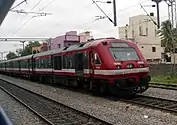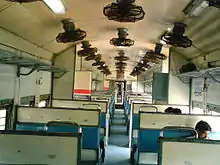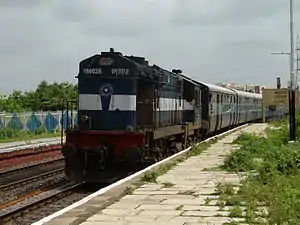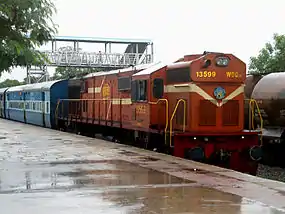Slow and fast passenger trains in India
The Slow and Fast Passenger trains are a series of passenger train services of Indian Railways which connect small towns and cities to metropolitan cities in India, which form the backbone of the economy and railways of India for future development.[1] The word Passenger states that it halts at all stations on the electrified and non-electrified railway routes. Currently, the total separate 3572 passenger trains are running of all railway zones of IR.
_Passenger.jpg.webp) Malda Town Azimganj Passenger Train | |
| Overview | |
|---|---|
| Service type | Connecting various states of India |
| Status | Operating |
| First service | 16 April 1853 |
| Current operator(s) | Indian Railways |
| Website | http://indianrail.gov.in |
| On-board services | |
| Class(es) | Unreserved Seating & Unreserved Sleeper |
| Seating arrangements | Yes |
| Sleeping arrangements | Yes |
| Catering facilities | On-board catering |
| Baggage facilities | Underseat |
| Technical | |
| Rolling stock | ICF rakes |
| Track gauge | Indian Gauge 1,676 mm (5 ft 6 in) |
| Operating speed | Maximum 40–80 km/h (25–50 mph) |
| Track owner(s) | Indian Railways |
History
The country's first passenger train from Western India, which ran between Bombay's (now Mumbai) Bori Bunder station (Now Chhatrapati Shivaji Maharaj Terminus) and Thane on 16 April 1853, was dedicated by Lord Dalhousie. The 14-carriage train was hauled by three steam locomotives: the Sahib, Sindh, and Sultan. Travelling 34 kilometres (21 mi), the train carried 400 people. The passenger line was built and operated by the Great Indian Peninsula Railway (GIPR).[2][3]It was built in 1,676 mm (5 ft 6 in) broad gauge, which became the country's standard for railways.
Later the country's second passenger train from Eastern India, which ran from Howrah (near Calcutta, now Kolkata) to Hoogly, a distance of 24 miles (39 km), on 15 August 1854. The line was built and operated by the East Indian Railway Company (EIR).[4]
And After that, the country's third passenger train from Southern India, which ran from Royapuram–Veyasarapady (Madras) (now Chennai) to Wallajah Road in Arcot, a distance of 60 miles (97 km), on 1 July 1856. It was built and operated by the Madras Railway.[5]
In 1897 lighting in passenger coaches was introduced by many railway companies. In 1902 the Jodhpur Railway became the first to introduce electric lights as standard fixtures.
Whereas The railway budget has commissioned to the electrification of railway lines in India which also started from Bombay (now Mumbai) to spread all over India with this aim, the first electric passenger train ran from Victoria Terminus (now Chhatrapati Shivaji Maharaj Terminus) to Kurla on the Harbour Branch of Great Indian Peninsula Railway on 3 February 1925 using 1500 V DC Overhead Traction.[6]
After that, In the year 1957, the First Diesel locomotive WDM-1 was introduced in India for reducing the usage of steam locomotives for goods and passenger transport.[7] and also begins the aim of replacing steam locomotives from Indian Rails after recommendation of Karnail Singh Fuel Committee.[8] And also that, Indian Railways began looking at various diesel-electric designs.
After that 1994, The Integral Coach Factory started production of DMU's and MEMU's with aim of this for connecting minor railway stations and stops on the mainline where most express trains don't have a halt. After productions of both series, the first MEMU train was started running between Asansol and Burdwan (now Barddhaman) on 11 July 1994.[9] And later, the first DEMU train was started running between Jalandhar and Hoshiarpur on 23 October 1994.[10]
On 15 July 2017, The new type of Solar-Powered DEMU train was launched on the route of Delhi Sarai Rohilla and Farrukhnagar of Haryana for connecting Capital of India to the small town with the aim reducing the usage of diesel and more usage of electricity for a better environment and economically.[11]
About
With the aim of connecting small towns and cities to another, this type of trains has an important priority to Indian Railways network. Mostly these trains are unreserved coaches, for short-distance unreserved seating coaches are used and for the long-distance unreserved sleeper and seating coaches are used. Passenger trains are classified into four types:
- Slow passenger trains are slow ordinary passenger trains in India. They stop at every station on the route, except abandoned ones.
- Fast passenger trains are fast ordinary passenger trains in India. They skip some stops on the route, mostly less-booked ones.
- Diesel Electric Multiple Unit (DEMU) are also comes in passenger trains of India. Stops at every station of the electrified and non-electrified route.
- Mainline Electric Multiple Unit (MEMU) are also comes in passenger trains of India. Stops at every station only of the electrified route for connecting suburban and rural areas.
In some cases, trains run as fast passengers on one section, while running as slow passengers on another section. Fast passenger trains generally run on longer routes as compared to slow passenger trains.
Mostly, the number of slow and fast passenger trains has an average trip up to 300km of distance on the other hand DEMU's and MEMU's have an average trip of more than 200km of distance.
Locomotives of Passenger trains
The passenger trains are usually hauled by locomotives by WAM4, WAG5, WAG7, for electrified route and WDM-2 for non-electrified and electrified route mostly, so the attachment and detachment of locomotives are done for changing and reversing the route which is time consumable and should be the higher risk of accidents.
DEMU and MEMU
On the other hand, the DEMU's and MEMU's have two-sided engines for changing and reversing the route which is a bigger advantage on the attachment-detachment process of rakes and locomotives. On this basis, Indian Railways is progressively replacing all locomotive-hauled slow and fast passenger and intercity trains with various EMU's. After replacing with EMUs, passenger trains would be re-branded as MEMU and DEMU. Conversion started from North Western Railway zone on 1 October 2015.[12][13][14][15]
Here the Types of DEMU and MEMU train
 A Old DEMU Train
A Old DEMU Train_DHMU_at_Alwal_02.jpg.webp) A Old DHMU Train
A Old DHMU Train An Aerodynamic Designed DEMU Train
An Aerodynamic Designed DEMU Train A Old MEMU train
A Old MEMU train A New Aerodynamic Designed MEMU train
A New Aerodynamic Designed MEMU train
Interiors
The Interiors of Passenger trains are as shown below:
 Right side corridor way of Inside unreserved passenger train
Right side corridor way of Inside unreserved passenger train Upper Rack of Inside unreserved passenger train
Upper Rack of Inside unreserved passenger train Side Window Seat of Inside unreserved passenger train
Side Window Seat of Inside unreserved passenger train Window, Middle and Aisle Seats of Inside unreserved passenger train
Window, Middle and Aisle Seats of Inside unreserved passenger train Left side corridor way of Inside unreserved passenger train
Left side corridor way of Inside unreserved passenger train Lights and Fans of Inside unreserved passenger train
Lights and Fans of Inside unreserved passenger train Another coach with wooden Seats of Inside unreserved passenger train
Another coach with wooden Seats of Inside unreserved passenger train Seating unreserved coach of Inside unreserved passenger train
Seating unreserved coach of Inside unreserved passenger train
Longest running slow and fast passenger trains
Currently, The longest route of a slow passenger train running in India is Tatanagar-Itwari Passenger (numbered 58111/58112) with a record distance of 887 km (551 mi) with an average speed of 35 km/h (22 mph).[16]
Whereas, The longest route of a fast passenger train running in India is Howrah–Rajgir Fast Passenger (numbered 53043/53044) with a record distance of 658 km (409 mi) with an average speed of 28 km/h (17 mph).[17]
Whereas after the second conversion of Slow Passenger train into DEMU, on 18 July 2018, the Guntur–Kacheguda DEMU via Dhone (with numbered 77281 / 77282) becomes the longest distance traveling DEMU train in India with a record distance of 623 km (387 mi) with an average speed of 35 km/h (22 mph).[18] Before that, the first conversion of Slow Passenger train into DEMU, was on 1 October 2015, the Jodhpur–Hisar DEMU (with numbered 74835/74836) becomes the Second longest DEMU train running in India with the recorded length of 470 km (290 mi) with an average speed of 38 km/h (24 mph).[19]
And Currently, The Longest route running MEMU train in India is Asansol-Varanasi MEMU (numbered 63553/63554) with a record distance of 481 km (299 mi) with an average speed of 31 km/h (19 mph).[20]
Shortest running slow and fast passenger trains
Currently, The shortest route of a slow passenger train in India is Barkakana-Sidhwar Passenger (numbered 53375 / 53376) with a record distance of 6 km (3.7 mi) with an average speed of 18 km/h (11 mph).[21]
The shortest route of DEMU train in India is Garhi Harsaru-Farrukhnagar DEMU (numbered 74031/34 & 74035/38) with a record distance of 11 km (6.8 mi) with an average speed of 27 km/h (17 mph).[22]
The shortest route of MEMU train in India is Jasidih-Baidyanathdham MEMU (numbered 63153/63154) with a record distance of 6 km (3.7 mi) with an average speed of 19 km/h (12 mph).[23]
Gallery
See also
| Wikimedia Commons has media related to Slow and fast passenger trains in India. |
References
- walkthroughindia.com, Retrieved 14 July 2020
- "164 Years Ago On This Day, India's First Train Ran From Mumbai To Thane".
- "India's 1st train: When Sahib, Sindh & Sultan blew steam - Times of India".
- "[IRFCA] Indian Railways FAQ: IR History: Early Days - 1". www.irfca.org.
- "Legacy of First Railway Station of South India". RailNews Media India Ltd.
- core.indianrailways.gov.com, Retrieved 7 July 2020
- "IRFCA".
- "Report of the expert Committee on Coal Consumption on Railways, 1958". INDIAN CULTURE. Retrieved 29 April 2020.
- irfca.org, Retrieved 7 July 2020
- indianexpress.com, Retrieved 7 July 2020
- jagranjosh.com, Retrieved 7 July 2020
- North Western Railway, Retrieved 9 July 2020
- North Western Railway, Retrieved 9 July 2020
- North Western Railway, Retrieved 9 July 2020
- North Western Railway, Retrieved 9 July 2020
- naidunia.com, Retrieved 12 July 2020
- jagran.com, Retrieved 12 July 2020
- South Central Railway, Retrieved 7 July 2020
- North Western Railway, Retrieved 8 July 2020
- Eastern Railways, Retrieved 10 July 2020
- livehindustan.com, Retrieved 12 July 2020
- india.com, Retrieved 12 July 2020
- bhaskar.com, Retrieved 12 July 2020





